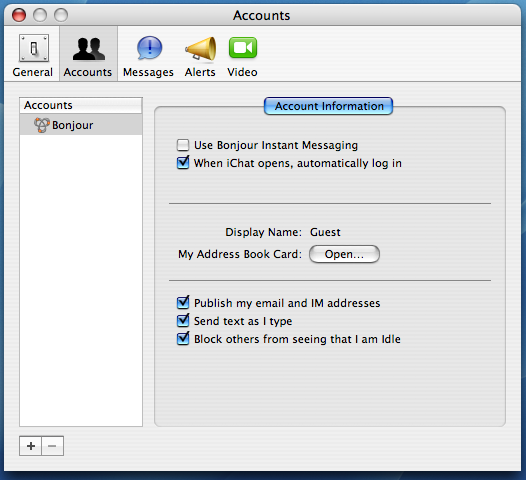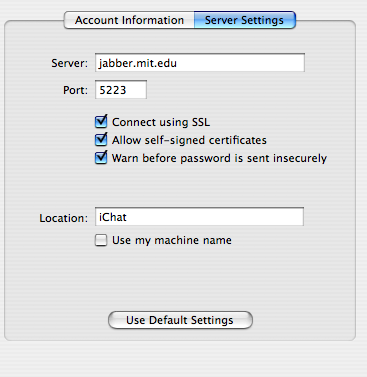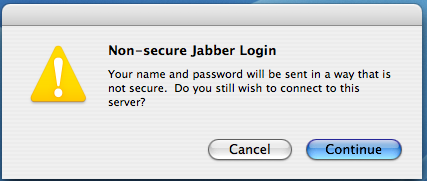Setting up iChat AV for Jabber:
- Choose "Preferences" from the "iChat" menu.
You should see something similar to this:
 (You may have other accounts listed if you have used iChat before.)
(You may have other accounts listed if you have used iChat before.)
- Click the plus sign at the bottom left of the window to add a new account. In the dialog box that appears, select "Jabber Acount" from the "account Type" dropdown menu.
- In the "Jabber ID" field, enter your username followed by "@mit.edu". Please note that this is your Kerberos username, the one you use to get MIT Personal Certificates. It is often the same as your e-mail address, but if you have another e-mail address (ie: username@PLANT.MIT.EDU, username@SLOAN.MIT.EDU), it will be different.
- In the Password field, you can choose to enter your Kerberos password. If you are the only user of your computer, you may wish to enter your Kerberos Password here, and iChat will save it for you. If you do not enter a password here, you will have to enter one each time you sign on to Jabber
- In the Server field, enter "jabber.mit.edu"
- In the Description field, you may enter an optional description of the account, for example "My MIT Jabber Account"
The dialog should look like this:

- Click "Add" to add your account.
- You will now be back at the "Accounts" tab of the iChat Preferences. Select your newly created Jabber account from the list on the left. On the right hand side,click the "Server Settings" tab.
- Change the Port number to 5223. Check the following checkboxes: "Connect using SSL", "Allow self-signed certiciates", "Warn if pasword is sent insecurely".
- It should now look like this:

-
You can then sign in to Jabber. Choose "Login to Jabber" from the "iChat" menu. If you did not choose to save your password, you will be prompted for it now.
- You may be presented with the followin dialog:

- Rest assured that your password is not being sent insecurely - this dialog is a result of incompatibilities between iChat and the Jabber server. Our Jabber server does not permit logins that do not use either SSL or TLS, and thus it is impossible to send your password in the clear.
 (You may have other accounts listed if you have used iChat before.)
(You may have other accounts listed if you have used iChat before.)



 (You may have other accounts listed if you have used iChat before.)
(You may have other accounts listed if you have used iChat before.)


